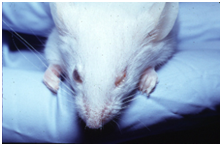Etiology: Rodentibacter pneumotropicus and Rodentibacter heylii are a Gram-negative, short pleomorphic rod with bipolar staining properties.
Incidence: The incidence of infection with Rodentibacter pneumotropicus and Rodentibacter heylii is common.
Transmission: Transmission by aerosol, fecal-oral, and contact with infected secretions (including venereal transmission) has been reported. The bacteria can be consistently isolated from the nasopharynx of subclinically infected mice and is considered an opportunistic pathogen, proliferating in the presence of other respiratory microbial pathogens.

Clinical Signs: The majority of infected immunocompetent mice exhibit no clinical signs. Infection has been associated with conjunctivitis and panophthalmitis in weanling and young adult mice (see photo). An upper respiratory infection can be manifest by an oculonasal discharge or torticollis from otitis media, and in the face of respiratory mycoplasmal or viral diseases, dyspnea may occur. Subcutaneous abscesses, mastitis, metritis and accessory sex gland abscesses are additional lesions observed in immune deficient mice.
Pathology: Infected tissues are characterized by mucopurulent inflammation with mild necrosis.
Diagnosis: Cultures of the ocular, skin or glandular tissues usually reveal mixed infections of Rodentibacter pneumotropicus and Rodentibacter heylii with other bacterial flora. Rodentibacter pneumotropicus and Rodentibacter heylii is likely to be isolated in pure cultures from abscesses in immune deficient mice. PCR can be used to confirm diagnosis.